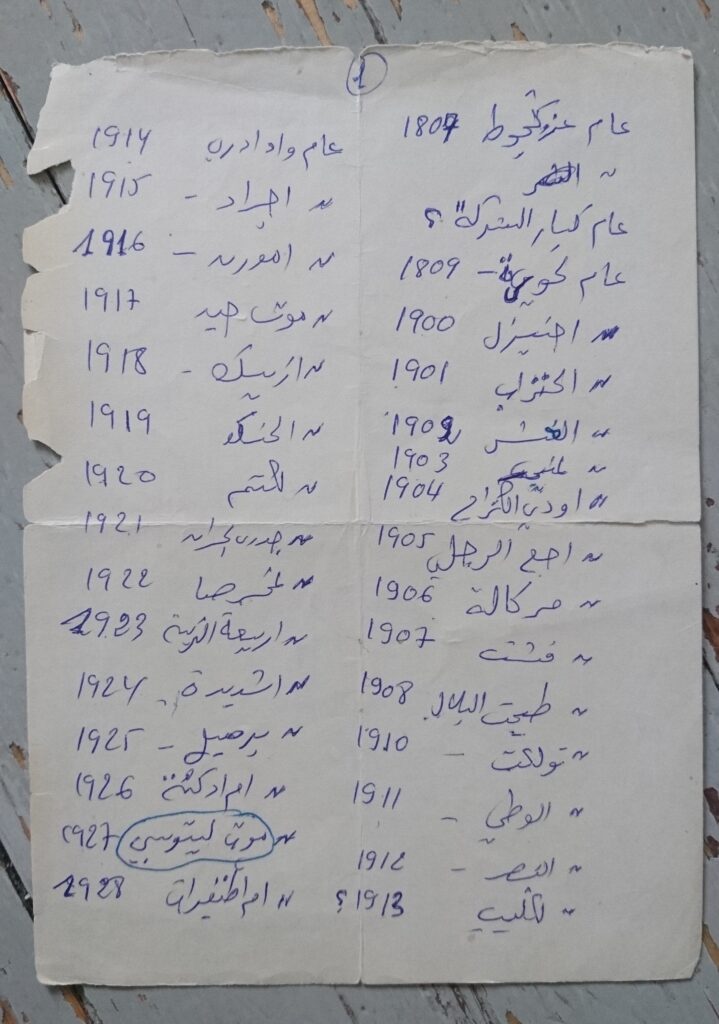THE NOMADIC CALENDAR
Or The Art of Naming the Years
– Ongoing Research Project in Motif Art Studio

The Sahrawi people of Western Sahara had long traditions of different oral expressions and narrations to communicate their arts and knowledge. This includes songs, poetry, oral stories, proverbs, oral wisdom and the Nomadic Calendar. The Nomadic Calendar is a unique way of telling time in a non-numerical way. Instead of numbers, the Sahrawi gave names to the years; every year was given a name. The practice of naming the years was based on the different events occurring in a particular year. The names carried stories and knowledges related to their surroundings, environmental phenomenon, social and political events, plants, seasons, stars, geographic references and much more.
It’s hard to trace the Nomadic Calendar in a linear regression because the Sahrawi were nomads. They were constantly moving across the desert. This means that if a family or a community witnessed an important event from which they coined the name of that particular year could possibly move to a different area the next year. Another family or community, living in a different location, may have witnessed a different event in that same year and came up with a different name. They didn’t have a way to coordinate the naming of years (Should it even be coordinated?). This resulted in some years having multiple names from different communities or tribes which only enriched the Nomadic Calendar as it enabled us to map out the different stories and events that took place in different parts of Western Sahara. As I follow and trace the Nomadic Calendar, I understand that it requires a lot of work to document the different year names and their stories from different locations.
The Nomadic Calendar preserved important knowledge related to landscape, plants, ecology and the social and political life of the Sahrawi people. The names they gave to the years were often poetic names that transmitted knowledge and history orally. The stories and encounters are important in the Sahrawi collective memory.
Here I list some examples from the Nomadic Calendar based on the version narrated by Sayd Ramdan (my maternal grandfather) and documented, for the first time, by Sulaiman Labat Abd (my father) who shared with me the original document with his own handwriting.
The Year of Alhenzab (1901)
The Year of Locusts (1915)
The Year of Scattering Stars (1934)
The Year of the Red Wind (1949)
The Year of Balls (1957) *Check our film about this year
The Nomadic Calendar connects time and space in a unique way. In this research, and as part of our way to decolonize our methodology of research on the Sahrawi oral history and knowledge, we focus and lean on the Sahrawi sources; oral and written. We will visit the testimonies, the stories, the interviews, the poems and the different Sahrawi archival materials to carry out this research. When collecting the Nomadic Calendar versions and knowledge, we are contacting different sources in order to ensure that contributions from different parts of Western Sahara can enrich this research.
My method to collect and study the Nomadic Calendar is organic, I often interview my father who I collaborate with in this long term research. He was the one to write the Nomadic Calendar from my grandfather. He has a lot of knowledge about the stories and meanings of the different names given to the years. He himself lived as a nomad for much of his early life in Western Sahara. I also connect with other Sahrawi families who have lived in different parts Western Sahara in order to collect their versions of the Nomadic Calendar. The different calendars overlap in some years, especially in the case of the events that have been witnessed by the entire region. They do however differ in many other years when it comes to regional events and local knowledges of certain areas. In my interview with Badi Mohamed Salem, he acknowledges the difficulty of collecting something as anarchic as the nomads’ movements and calendar, but he also referred to the fact that people exchanged the years’ names differences during their nomadic encounters and conversations.
The Nomadic Calendar presents an autochthonous method used by the Sahrawi to tell time using oral references that carry their stories and knowledges in such a poetic way.
We will be updating this page with new input as we move forward with the process of documenting and research the Nomadic Calendar of the Sahrawi people.
The Team
This research project is a collaboration between me Mohamed Sleiman Labat and my father Sulaiman Labat Abd. The physical copy of the The Nomadic Calendar can be viewed in the archive of Motif Art Studio, Samara Camp.

